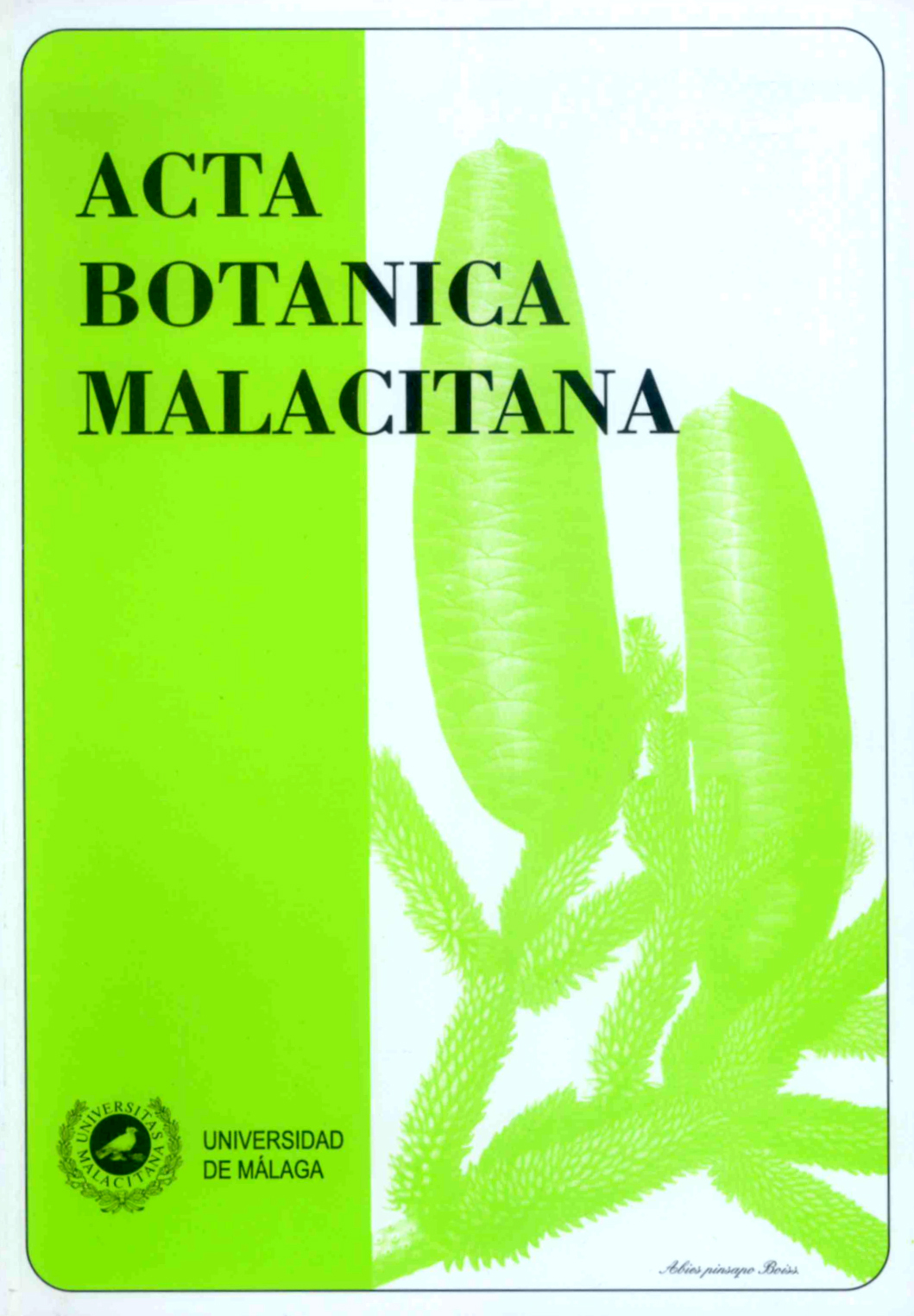Catálogo florístico del Macizo de Líbar (Parques Naturales Sierra de Grazalema y Los Alcornocales, Málaga-Cádiz, España).
DOI:
https://doi.org/10.24310/abm.v32i0.7035Abstract
RESUMEN. Catálogo florístico del macizo de Líbar (Parques Naturales Sierra de Grazalema y los
Alconocales, Málaga-Cádiz, España). El Macizo de Líbar es uno de los conjuntos montañosos más
importantes de la Serranía de Ronda y Andalucía Occidental. Su principal característica orográfica
es la presencia de dos alineaciones montañosas que encierran una gran depresión intramontañosa
denominada genéricamente los Llanos de Líbar. La vegetación dominante en los terrenos de naturaleza
caliza la constituye el encinar, mientras que el alcornocal lo es de aquellas zonas donde afloran las
areniscas del Aljibe. A estas formaciones vegetales se suman otras como los quejigales, acebuchales,
algarrobales, fresnedas, olmedas, adelfares y diversas formaciones de matorral. La climatología queda
marcada por ser una de las zonas con mayor precipitación de la Península Ibérica y por unas
temperaturas bastante suaves durante todo el año, aunque en las zonas más altas la media anual se
aproxima a los 10 ºC. Para llevar a cabo el estudio florístico del Macizo de Líbar se han realizado
recolecciones durante cinco años, en las que se ha pretendido herborizar la mayor parte del macizo,
además de una revisión bibliográfica y consultas de los pliegos depositados en herbarios. El catálogo
florístico del Macizo de Líbar está formado por 826 taxones. De estos, 128 son endemismos, repartidos
en endemismos ibéricos, ibero-mauritanos, bético, béticos-mauritanos, y rondeños. Son endemismos
Rondeños Linaria platycalyx, Reseda gayana subsp. undata, Saxifraga bourgeana, entre otros. Trece
especies están protegidas según la Ley de Flora y Fauna Silvestres de Andalucía y 32 taxones están
incluidos en la lista Roja de la Flora Vascular de Andalucía.
Palabras claves. Flora, Catálogo, Macizo de Líbar, Sierra de Grazalema, Los Alcornocales, Málaga,
Cádiz.
ABSTRACT. Floristic catalogue of the Macizo of Libar (Natural Parks of Sierra de Grazalema and
Los Alcornocales. Malaga-Cadiz, Spain). The Mountain of Líbar is one of the most important ranges
of the mountainous area of Ronda and Western Andalusia. Its main orographic characteristic is the
presence of two mountainous alignments that delimit a great intramountainous depression denominated
Llanos de Líbar. The Quercus rotundifolia wood is the main vegetation in limestone lands, whereas
the Q. suber forest is dominant in sandstone zones. Other plants communities present in this area are
dominated by Q. faginea, Olea europaea, Ceratonia siliqua, Fraxinus angustifolia, Ulmus minor,
Nerium oleander and other shrublands. This is one of the zones with highest rainfall in the Iberian
Peninsula and with mild temperatures, although in the summits, the annual average temperature,
decreases near 10 ºC. In order to carry out the botanical study, samplings have been made during five
years, in addition to a bibliographical revision and review of biodiversity databases. The botanical
catalogue of Líbar is composed by 826 species, 128 are endemic species with different distribution
area. Linaria platycalyx, Reseda gayana subsp. undata or Saxifraga bourgeana are endemic from the
area of Ronda. 13 species are protected according to the Law of Wild Flora and Fauna of Andalusia
and 32 species are included in the plants Red List of Andalusia.
Key words. Flora, Catalogue, Macizo de Líbar, Sierra de Grazalema, Los Alcornocales, Málaga,
Cádiz.
Downloads
Metrics
Downloads
Published
How to Cite
Issue
Section
License
Those authors who publish in this journal accept the following terms:
a. The authors will retain their copyrights and guarantee the journal the right of first publication of their work, which will be simultaneously subject to the Creative Commons Attribution-Non-commercial 4.0 license whose full text can be found at <http: // creative commons .org / licenses / by-nc / 4.0> that allows third parties to share the work as long as its author and its first publication are indicated, and as long as it is not for commercial purposes.
b. Authors may adopt other non-exclusive licensing agreements for the distribution of the version of the published paper (e.g., deposit it in an institutional telematic file or publish it in a monographic volume) provided that the initial publication in this journal be indicated.
c. Authors are allowed and recommended to disseminate their work through the Internet (e.g., in institutional telematic archives or on their websites) before and during the submission process, which can produce interesting exchanges and increase citations of the published work. (See The effect of open access)







1.png)
